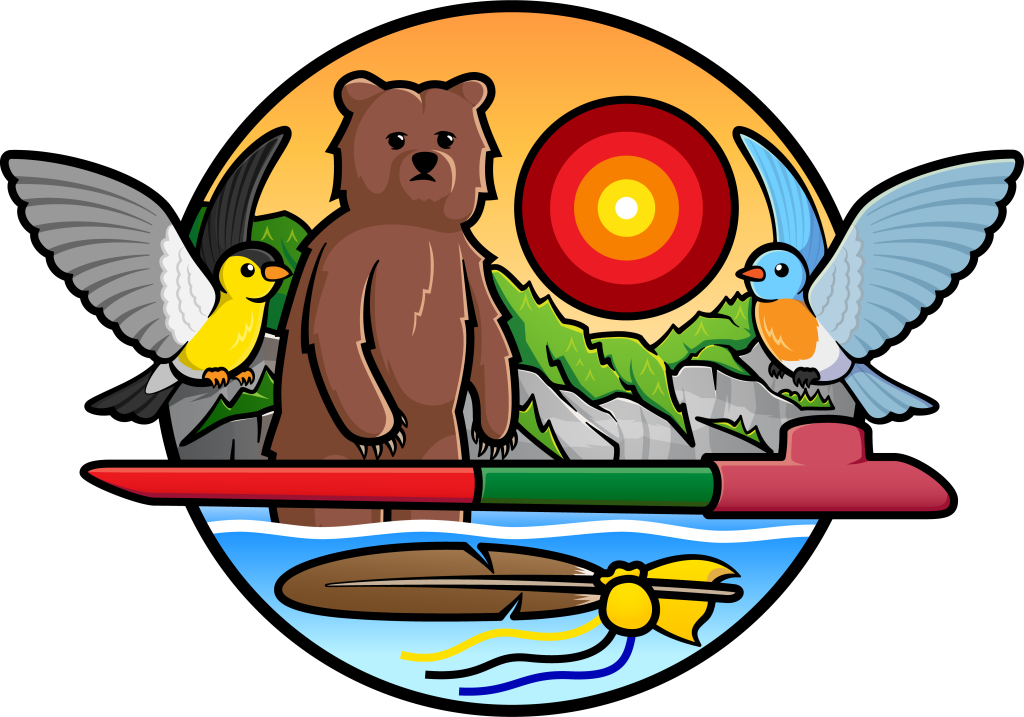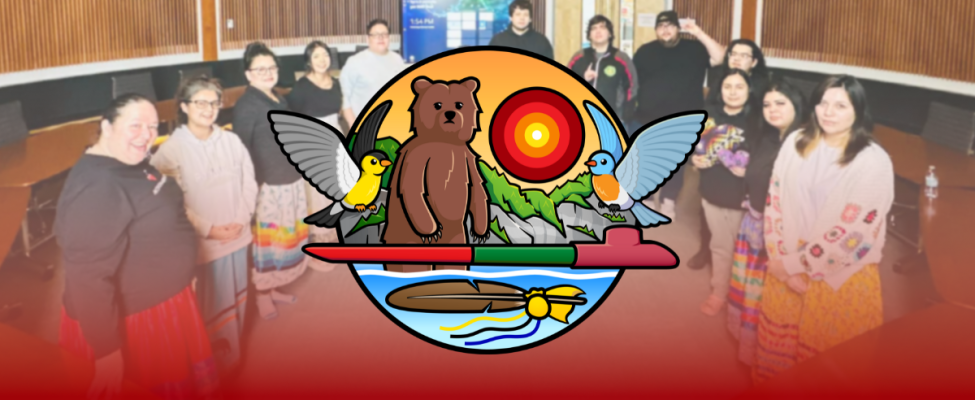“It’s a good thing to carry the language, but it’s a great thing to also carry the heart and soul of the language,” said SGEI Anishinaabemowin educator Robert Animikii Horton. “When learners are introduced to that way of thinking, they’re forever changed.”
Shortly before Elder and former Chief of Manitou Rapids Willie Wilson passed away, he tasked Horton with creating a method to teach Anishinaabemowin easier and faster without losing the soul of the language.
“At the end of his life, he knew where the pitfalls were and where the successes were, so his advice was very golden,” said Horton.
Another one of Horton’s teachers, the late Richard Morrison from Nigigoonsiminikaaning First Nation, taught him about the deeper esoterics that are often hidden in the language past communication and phonology.
“During the COVID lockdown, I had a lot of time to reflect on those two guys,” said Horton. “I asked myself, ‘How do we teach this?’ — ensuring the learners understand the deeper esoterics and the linguistic universe of the language, but also making sure they pick it up quicker and easier.”
So, to live up to his title as Gaa-aazhide-gikinoo’amaaged (One Who Teaches Across Philosophies), Horton decided to study four different disciplines — educational psychology, neurology, linguistics, and marketing.
“And what I decided to do is twist those together, so they mix and reinforce one another. I was trying to find a way to create a brain hack.”
The Anishinaabemowin revitalization program that Horton teaches derives from those four areas and follows the lessons from Horton’s former teachers, Wilson and Morrison.
“It works like a charm. Our students are having short conversations within about a month. Their vocabulary is up in the thousands in a year and a half. It’s pretty awesome.”
Horton also pointed to SGEI CEO Brent Tookenay and SayITFirst founder Mike Parkhill as two more pillars of the program’s success.
“They created many of the opportunities and allowed it to be developed with equal parts support and encouragement,” he said. “Those four men and their influence, I mean, them and our team, that’s the reason why we’re in our third cohort of very successful language folks.”
Horton’s current class of 15 learners is now midway through their three years at SGEI.
So far, he says the class has been focused on something called indicative mode — the most straightforward representation of the language.
“We’re going to be getting more advanced where things are added to phrases to give them a whole lot more meaning,” said Horton. “For instance, if I want to say that I used to sleep (but not anymore), that can be conveyed.”
He also said they’re getting into deeper conversation, more vocabulary, and just “raising the bar” on what is transmitted.
“What’s cool about the program is that they’re getting the language, they’re getting ancient teachings, but they’re also receiving skills to make them independent so they can navigate careers and opportunities.”
His students are learning how to get a mortgage, budget, prepare a resumé, register to vote, and more.
“That eagle carrying the walleye on SGEI’s logo, that was put there as a symbol of self-reliance,” said Horton. “And that’s built right into what we’re doing.”
Cultural growth
As Anishinaabemowin learners develop in the program, they gradually build a bundle simultaneously.
With each item made, gifted, or earned, the students slowly learn how to carry them respectfully and how each item supports them during their learning.
“At the end of the program, they will have tobacco bags, hand drums, ribbon shirts/skirts, shakers, things like that for personal use,” said Horton. “They also gain accurate understandings.”
On top of that, Horton’s students have been engaging in ceremonies more, with men joining the drummers, and women serving as staff holders.
“When they have finished with the program, we’ll probably ask more in the next cohort to do the same, so they get full spectrum learning.”
The students have also been helping with annual SGEI events like Gagwe-gikendamaawiziwin (Quest for Knowledge) and Dagwaagani-mawindoosijigewin (Fall Harvest).
“They’re learning how to organize events. So, if they end up in a career where they’re working in their home community, they have the tools and the know-how to put on language events.”
What do language learners do after graduating?
“One of the biggest trends is teaching.”
Horton said graduates have brought back their knowledge to their communities, while others have gone on to teach for the Rainy River District School Board (RRDSB) and at SGEI on the Anishinaabemodaa team.
“Our former students have been typically at the high school level, but there are also many opportunities within the region, so either way, they’ve been involved in their teaching,” he said. “We’ve lit a fire under them, and it just continues to grow.”
There are also people working in cultural capacities for local organizations, and some graduates are furthering their education, looking to obtain bachelor’s or master’s degrees.
Horton’s students come from the surrounding First Nations in Treaty 3.
“The way that I see it, I call it seeding the language,” said Horton. “Imagine if every community built up four or five speakers who are really knowledgeable, comfortable, confident Anishinaabemowin linguists. That’s how we get this [language] back.”
Revitalization
“It’s sort of like a race against time,” said Horton.
He said crucial parts of revitalization are linguistics, philology, and discovering patterns — looking at the original intent of language.
“Some have said that, in the greater scheme of it, deeper meanings are a bit scattered because many learners might not discover the original meaning of words. This can be done by looking at the intersection between symbology, protocols, etymology, consistency, and history. And where those all converge, they point to original meaning and intent. And to me, that keeps the heart and soul of it safe.
“I believe the language is like a table, and on that table, there’s many things — ceremony, protocol, philosophy. So, if the table gets kicked out, these things fall, and that’s exactly why the residential schools hit our families so hard. Because if you target the language, you target everything that it holds up.
“But if you make that table strong, it protects these things. And if you grow the table, you can put more on it.”
Anishinaabemowini-ogichitaag
This winter, Horton’s program was given a new name: Anishinaabemowini-ogichitaag. On the surface, the new name means “Anishinaabe Language Warriors.”
“But that’s not what it means,” he said. “It’s often misunderstood with a long history.”
What ogichidaa means is “a being that has come from the spirit world and resides within a bodily vessel, and that person is doing something significant to enhance life, peace, and unity.”
Anishinaabemowini is “using one’s life energy to speak forth energy from the being that is lowered to this place from above.”
“Now, this is where it gets interesting. There were discussions of a logo for the program,” said Horton. “That logo has been developed by a series of dreams since I’ve been helping take care of our language, drum, and staff here.”
Horton shared his dreams during the program’s naming ceremony, and soon after, Waking Up Ojibwe – Anishinaabemodaa’s illustrator Tim Smith designed the logo to the right.
The Anishinaabemowini-ogichitaag logo includes Aginjibagwesi (American goldfinch) and Ozhaawashko-bineshiinh (bluebird).
“Those two are helpers, and they are very influential to the success of the program.”
Below them is an eagle feather with yellow cloth and colours that also acknowledge those two birds.

“There’s also a pipe that’s going to be made to help ensure this program is successful.”
In the middle is a grizzly bear standing in shallow water on the lake with rocky cliffs behind them. Above it all is a rising sun, our drum, Saagajiwe.
Teaching the language
Anishinaabemowini-ogichitaag operates under Waking Up Ojibwe – Anishinaabemodaa — a language strategy partnership comprised of SayITFirst, the RRDSB, and SGEI.
The language strategy began in 2017 as a partnership between SayITFirst, the RRDSB, and SGEI with its 10 governing communities. In 2020, support from the Mastercard Foundation sustained the initiative’s momentum and enhanced its community impact.
“It’s the greatest job in the world,” said Horton. “I see it as something very noble. It’s probably my biggest passion.”
To him, it has to do with contribution and family legacy. The late Delbert Horton, SGEI’s founder, was his uncle.
“There’s many people in my family who came before who were committed language educators,” he said.
Horton’s mother and grandmother were respected Anishinaabemowin leaders, and their family’s grandfather was none other than Mawedobines, the Indigenous spokesperson for the signing of Treaty 3 in 1873.
Having now taught two successful cohorts of Anishinaabemowini-ogichitaag, Horton seems to be following in the right path, and his passion is evident.
“We’re swinging the bat hard for that home run every day,” he said.
The next intake for Anishinaabemowini-ogichitaag is January 2027. If you’re interested in learning to speak Anishinaabemowin, please reach out to Anishinaabemodaa – Waking Up Ojibwe at wakingupojibwe.ca
